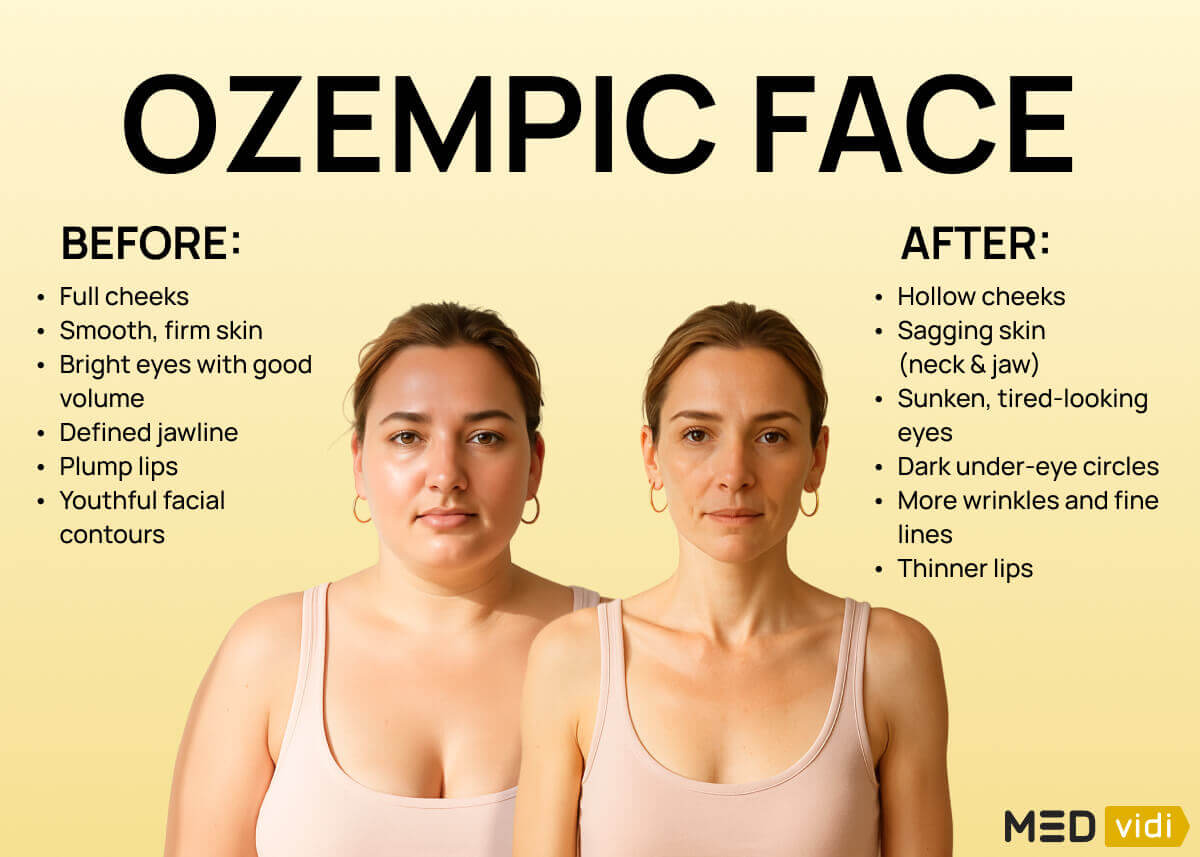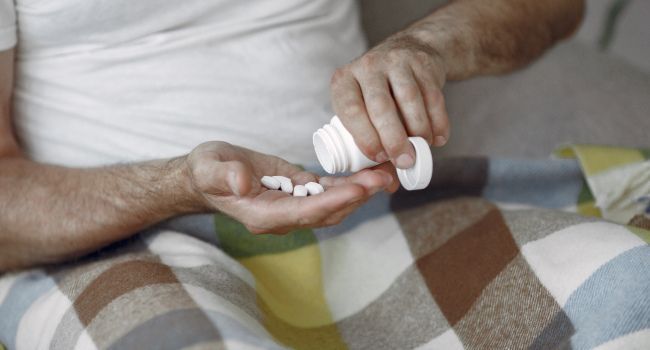Ozempic (semaglutide) has a
- Ozempic face describes the face changes that might occur after using semaglutide for weight loss.
- Signs of an Ozempic face can include sunken eyes, hollow cheeks, sagging skin, and wrinkles.
- Ozempic face is not a direct side effect of the medication, but rather a result of rapid weight loss that affects the facial fat cushions.
- The best advice for avoiding the Ozempic face is to ensure a gradual weight loss, giving the skin time to adapt.
- Ozempic, a trade name of semaglutide, is a medication registered for glucose control in patients with diabetes and used off-label for weight loss; Wegovy (semaglutide) is registered for weight management in the USA.
The media is buzzing with stories about Ozempic face, but before we can get into this topic, you’ll need some background.
Ozempic, the generic name of which is semaglutide, was initially developed to manage diabetes type 2, but it was also found to have a positive effect on weight loss. Ozempic became a popular off-label weight loss medication, and subsequently, the FDA approved semaglutide under the trade name Wegovy to treat obesity
Unfortunately, people using Ozempic for weight management, and outsiders following semaglutide users’ weight loss journey, sometimes notice facial changes on the semaglutide, and not for the better.
In this article, we will answer the question, “Is Ozempic face real?” as well as how to prevent and treat it.
What Is Ozempic Face?
“Ozempic face” means the gaunt appearance and loose skin resulting from rapid weight loss when taking Ozempic. It is not an official medical term, but a phrase popularized by the media. Other less common terms are “Ozempic weight loss face,” “semaglutide face,” and “Wegovy face.”
Kugler T. American Academy of Facial Plastic and Reconstructive Surgery. American Academy of Facial Plastic and Reconstructive Surgery. Published 2023. Accessed June 9, 2025.
Other weight loss medications in the same class as Ozempic, glucagon-like peptide-1 (GLP-1) agonists, can also lead to rapid weight loss. So, there are also terms like tirzepatide face, Mounjaro face, and Zepbound face on online platforms.
Let’s look at why.
GLP-1 is a
- Are less hungry
- Feel satisfied after a meal
- Feel fuller for longer
- Have fewer cravings for sugars and refined carbohydrates
- Experience nausea at the beginning of treatment
“Ozempic face” has become the blanket term for this post-GLP-1 receptor agonist appearance because celebrities and influencers have demonstrated their rapid weight loss,
Psychosocial Impact and Media Perception
The web is filled with Ozempic face before and after pictures; some people might share their transformation because they aren’t happy with the change and want to raise awareness; for others, the motivation might be pride about the weight they have lost, expecting congratulations rather than comments about sagging skin and wrinkles.
However, social media thrives on controversial health topics, especially “vanity gone wrong”. Unfortunately, it is human nature to find something satisfying in the misfortune of others; it makes people feel better about themselves somehow, or it might give a sense of justice. For example, one may think that using a “quick fix medication” to lose weight instead of the challenging route of lifestyle changes should have consequences.
Social media provides anonymity and emotional distancing, allowing judgment to become clickbait and Ozempic face photographs to go viral, — leaving little room to consider why people were prescribed semaglutide in the first place.
This can have emotional and social consequences, and people who have facial changes due to semaglutide use might:
- Experience body shame, become obsessed with appearance, and feel unattractive.
- Have poor self-esteem, lose confidence, avoid social interactions, and isolate themselves.
- Develop mental health conditions like depression and anxiety.
- Lose trust in healthcare professionals.
- Stop their vital medication.
Also, people who legitimately need GLP-1 receptor agonists may refuse treatment because of fear of judgement, or the cosmetic consequences.
This is why balanced, factual conversations around this topic are essential.
People should be informed that GLP-1 receptor agonists are not necessarily the problem, but their inappropriate use, or fast and significant weight loss, is.
What Does Ozempic Face Look Like?
Another way to describe Ozempic face is
- Sunken eyes
- Dark circles around the eyes
- Sagging skin, especially around the neck and jaw
- More wrinkles and fine lines
- Thin lips
- Hollow cheeks

What Causes Ozempic Face?
The facial appearance changes while on Ozempic are not a direct effect of the medication but rather a natural consequence of weight loss.
When losing weight on GLP-1 receptor agonists, fat loss occurs everywhere, including facial fat. Ozempic face starts when these facial fat pads shrink, leaving dents, dips, or thinning where they once were; also, there is no longer support for the skin over these areas, so it sags and wrinkles.
"“Ozempic face” can also result from a disproportionate loss of muscle tissue due to unintentional and poor eating habits among patients taking GLP-1 medication like Ozempic. When the body goes through a relative protein deficit, it will utilize existing muscle tissue (including facial muscles) to supply essential amino acids for necessary body functions, which can show up in facial structure as well. This points to the extremely important role of proper nutrition during weight loss.
Make sure to consult with your healthcare provider prior to making any medication or lifestyle changes."

These indirect Ozempic ‘side effects’ on skin can happen anywhere there are fatty deposits, including the neck, arms, legs, belly, and breasts, and have led to phrases like:
- Ozempic skin
- Ozempic butt
- Ozempic chin
- Ozempic body
Because semaglutide often causes rapid weight loss, — an average of
However, it makes sense that any cause of extreme weight loss can cause the same hollowed-out facial look, including using other weight loss medications such as appetite suppressants or unintentionally losing weight due to famine, illness, or extreme hardship.
Naturally, the next question is, does everyone get Ozempic face?
Who Is Most at Risk?
Unfortunately, anyone who loses weight rapidly will be at risk, but older patients are more prone to having facial changes because of weight loss on GLP-1 receptor agonists. Losing facial volume and low facial skin elasticity is part of the natural aging process, so they are starting with a disadvantage.

Some people don’t lose a lot of weight or don’t lose it quickly. A trial showed that after 68 weeks on semaglutide:
- 13.6% did not lose at least5% and can be considered non-responders.
- 30.9% did not lose at least 10%
- 49.5% did not lose at least15%
Still, it means that many of those taking semaglutide have more significant weight loss results and can experience Ozempic face.
People who have to lose more weight to get to their goal, for example, 100 pounds vs 20 pounds, are more likely to have noticeable changes. Also, because
Other Side Effects of Ozempic
Like any other weight loss prescription medication, semaglutide has many possible side effects:
- Pain and redness at the injection site
- Low blood sugar
- Nausea and vomiting
- Diarrhea or constipation
- Abdominal pain
- Gallsotones
- Inflamed pancreas
- Risk of thyroid tumors
- Tiredness
- Dizziness
- Headache
- Rashes and allergies
- Anxiety
- Hair loss
You should contact a doctor immediately if anything unusual develops after starting a new medication.
Can You Avoid Getting Ozempic Face Changes?
The most accurate advice on how not to get Ozempic face is to ensure a slower weight loss.
This means 1 to 2 pounds per week for 6 months, then reassess. Lower doses might help to slowly reach a healthy weight, in combination with long-term lifestyle changes as a part of weight management strategy to maintain low body fat.
Other tips on how to prevent Ozempic face are focused on good overall health, ensuring healthy skin by stimulating elastin and collagen production and supporting the skin from underneath with a structure of muscle rather than fat.
- Taking part in exercise programs can help to
build muscle[7] in the buttocks, arms, and legs that can support the skin and add shape as the fat layer disappears. - Hydrolyzed collagen supplementation might
improve skin hydration and elasticity[8] , which helps the appearance of fine lines and skin firmness. - Avoiding sun exposure by wearing hats and daily sunscreen reduces photo-aging and damage.
- A balanced diet rich in antioxidants, iron, iodine, zinc, and copper, vitamins A to E, and protein helps to ensure that skin stays inflammation-free and can heal, repair, and build skin and muscles.
- Staying hydrated is so important. Water makes up
more than 70% of body[9] cells and is essential for normal functioning. The skin is no different and is the largest organ in the body; dry skin cannot function properly. - Stopping alcohol and smoking cigarettes
can delay skin aging[10] . - Looking after your skin with a good routine. It is important to clean and moisturize your skin twice a day, not forgetting the sunscreen. Read cream labels to see if they contain
other ingredients that may help[11] to improve hydration, elasticity, and collagen function, such as hyaluronic acid and peptides.
But what if you’ve tried all of the above and still see facial changes?
Treatment Options
The idea behind cosmetic Ozempic face treatments is to restore lost volume and facial shape and improve skin elasticity and texture with skin tightening procedures. This can be done with non-surgical cosmetic procedures and plastic surgery.
Non-Surgical Treatments
- Dermal fillers: Injectable facial fillers, especially ones that contain hyaluronic acid, restore volume and shape and increase skin hydration and elasticity.
- Platelet-rich plasma (PRP) injections: PRP is made from the patient’s blood and is rich in growth factors that trigger skin repair.
- Microneedling: Also called percutaneous collagen induction therapy, tiny needles injure the top layer of skin, which stimulates collagen production and improves skin elasticity.
Surgical Options
Any surgery carries the risks of anaesthesia, pain, bleeding, scarring, and infection; however, the results last longer than the non-surgical procedures. Consult with a healthcare provider to weigh all the benefits and risks.
- Autologous fat grafting: This procedure involves fat transfer from one body area to another, for example, from the thigh to the face. It is harvested using liposuction techniques, processed, and injected at the new site.
- Cheek implants: Implants are made from artificial materials and add definition to the cheeks. Surgeons place them under the skin through a cut made inside the mouth or under the eyelid.
- Facelift and neck lift:
This surgery[12] involves removing and repositioning loose skin for a smoother, tighter, more youthful appearance.
Natural Strategies
The tips on how to fix an Ozempic face naturally will be similar to the advice for preventing it. Hydrolyzed collagen supplementation, eating a balanced diet, exercising, avoiding the sun, stopping smoking and alcohol, and looking after skin with a good daily routine may help to improve the appearance of fine lines and skin firmness. Importantly, these are not solutions for restoring the face’s shape.
Does Ozempic Face Go Away or Is It Permanent?
Once the weight and fat are lost, Ozempic face will not automatically go away or improve over time. Sometimes, facial appearance might improve after stopping semaglutide, as
Conclusion
As you’ve learned, the rapid weight loss caused by Ozempic and other GLP-1 receptor agonists can lead to unwanted facial changes referred to on social media as Ozempic face. Understandably, this may worry you.
If you believe you qualify for weight loss treatment, discuss this with a healthcare provider. MEDvidi has licensed medical professionals who specialize in weight loss management, so advice is an online appointment away.
Frequently Asked Questions
Does Ozempic age you?
Does Ozempic face go away after you stop using it?
Is Ozempic face reversible?
Ozempic face might improve after stopping semaglutide because many people regain weight, and the facial fat pads may reappear; however, this is not guaranteed.
Does Ozempic get rid of belly fat?
Yes, Ozempic causes nonselective fat loss, targeting all of the body’s fatty deposits.
Does Ozempic leave saggy skin?
What is an Ozempic butt?
Ozempic butt is the term used to describe the loss of shape, dimpling, and sagging skin of the buttocks seen after substantial weight loss from using Ozempic.
Does taking collagen help with Ozempic face?
Taking hydrolyzed collagen supplementation might help Ozempic face by











